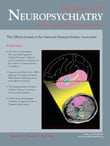Central Hyperdopaminergism in Peduncular Hallucinosis
SIR : Peduncular hallucinosis produces vivid, nonstereotyped, continuous, gloomy or colorful visual images that are more pronounced in murky environments. 1 , 2 It is of great interest that the corresponding site for peduncular hallucinosis, substantia nigra pars reticulata (SNpr), 3 has no known role in the visual process and analysis.
Case Report
An elderly man experienced a sudden onset of visual images in the evening when he was watching television at home. He saw three children dressed in dark or yellow colors playing and laughing in front of him. They did not respond when he called to them. He felt strange and knew that this was not real. He did not feel fear. The children disappeared 1 hour later. That night, he complained to his family of two similar episodes. Unfortunately, right side weakness, double vision, and sleepiness developed consequently.
On presentation, his blood pressure was 180/90 mmHg. He was sleepy but could be awakened easily. His eyegrounds showed grade I hypertensive retinopathy. Visual field, acuity, and color perception were preserved. Left oculomotor nerve palsy and right hemiparesis compatible with Weber’s syndrome were detected. Magnetic resonance imaging revealed a left midbrain infarct involving the crus cerebri and SNpr. Visual imaginery lasted for 7 days.
His serum thyrotropin, T4, cortisol, corticotrophin, and gonadal hormones were normal in the acute phase of stroke. A normal prolactin and thyrotropin response to protrelin and cortisol response to low dose dexamethasone were obtained. However, serum prolactin level increased only 0.9-fold and 0.89-fold within 3 hours after a 12.5 mg and 25.0 mg chloropromazine injection, respectively, in contrast to 1.3-fold in normal subjects. A decrease of peak level to 50.6 ng/ml (normal: 66.63 [SD=7.8 ng/ml]) and mean maximal increment to 29.3 ng/ml (normal: 55.17 [SD=11.30 ng/ml]) were detected 90 minutes after haloperidol infusion. The area under curve was 4,140 ng/ml/min (normal: 7,649 [SD=1,123] ng/ml/min) which was only 54% of normal. Two months later, his serum prolactin level increased 1.33-fold after a 12.5 mg chloropromazine injection.
His neurohormonal results could not be explained by stroke. A blunted prolactin response to chloropromazine and haloperidol indicates a hyperdopaminergism in the hypothalamus-adenohypophysis axis. A hyperactivity of pituitary D 2R is preferred as other neurohormones which are also secreted from arcuate nucleus are normal.
Comment
A similar blunted prolactin response to haloperidol is also seen in schizophrenia patients. 4 We interpret a preconditioned involvement of D 2R in multiple locations, rather than being restricted to the mesocorticolimbic system. A preconditioned involvement of D R out of the SNpr’s pathway may contribute to peduncular hallucinosis. The A10 DA neurons innervate the primary visual cortex, particularly the lamina VI, which modulates geniculate activity, and lamina V, which regulates superior colliculus. 5 A disconnection of these structures may reduce visual input to visual cortex or induce cortical excitation to produce visual imaginery without affecting the visual function. Indeed, occipital hypometabolism has been found in peduncular hallucinosis. 2 Additionally, a preconditioned vulnerability of D 2R also explains the rarity of peduncular hallucinosis among patients with midbrain lesions.
1. Kolmel HW: Peduncular hallucinations. J Neurol 1991; 238:457–459Google Scholar
2. Manford M, Andermann F: Complex visual hallucinations: clinical and neurobiological insights. Brain 1998; 121:1819–1840.Google Scholar
3. Mckee AC, Levine DN, Kowall NW, et al: Peduncular hallucinosis associated with isolated infarction of the substantia nigra pars reticulata. Ann Neurol 1990; 27:500–504.Google Scholar
4. Keks NA, Copolov DL, Singh BS: Abnormal prolactin response to haloperidol challenge in men with schizophrenia. Am J Psychiatry 1987; 144:1335–1337.Google Scholar
5. Phillipson OT, Kilpatrick IC, Jones MW: Dopaminergic innervation of the primary visual cortex in the rat, and some correlations with human cortex. Brain Res Bull 1987; 18:621–633Google Scholar



